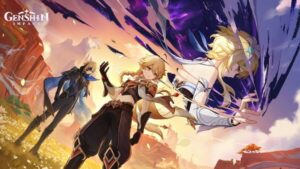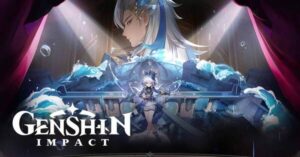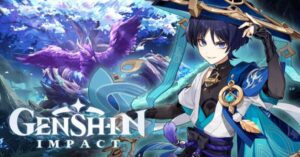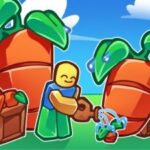
Genshin Impact
All trademarks belong to their respective owners.
Advertisement
Popular Now
Introduction
Since its global launch in September 2020, miHoYo (now HoYoverse)'s Genshin Impact has captivated millions with its breathtaking open world, compelling characters, and engaging elemental combat. However, beneath the polished exterior of Teyvat lies a system that has consistently been the bane of many a traveler's existence: the Artifact system. While ostensibly designed to allow players to customize and strengthen their characters, the inherent randomness and punishing nature of artifact farming have transformed it from a rewarding pursuit into a source of perpetual frustration, often leading to player burnout and disengagement. This article will delve deep into the multifaceted issues plaguing Genshin Impact's Artifact system, exploring its fundamental design flaws, the psychological impact on players, and potential avenues for improvement, examining how this singular mechanic has become a central point of contention in an otherwise critically acclaimed title.
The Genesis of Frustration: Understanding Artifact Fundamentals
At its core, the Artifact system in Genshin Impact is straightforward. Characters can equip five pieces of artifacts: Flower of Life, Plume of Death, Sands of Eon, Goblet of Eonothem, and Circlet of Logos. Each piece has a main stat, and up to four substats. The Flower always has HP as its main stat, and the Plume always has ATK. The Sands, Goblet, and Circlet, however, have a diverse pool of potential main stats, with some being significantly rarer and more desirable than others, such as Elemental DMG Bonus on the Goblet or Crit Rate/Crit DMG on the Circlet. The first layer of RNG (Random Number Generation) appears when obtaining artifacts from domains. Players spend their precious Resin – a limited resource that regenerates slowly – to clear these domains, hoping for the specific set and main stat they desire. This initial hurdle is often the least of a player's worries, as the true despair lies in what comes next: the substats and the upgrading process.Substat Scramble: The Real Grind Begins
Once an artifact with a desirable main stat and set is acquired, the focus shifts to its substats. Each artifact can have between three and four substats upon acquisition. If it has three, a fourth substat is added at level 4. After this, at levels 8, 12, 16, and 20, one of the existing substats is randomly "rolled," increasing its value. This is where the overwhelming majority of player frustration stems from. The sheer number of possible substat combinations, coupled with the random nature of which substat gets upgraded, means that acquiring a "god-tier" artifact – one with optimal main and substats, and all substat rolls going into desirable stats – is an astronomically low probability event. Players often find themselves with countless artifacts that look promising on paper, only for them to "brick" during the upgrade process, meaning all the rolls go into undesirable substats like flat DEF or flat HP. This leads to an endless cycle of farming, upgrading, and discarding, a process that consumes not just in-game resources but also significant player time and mental energy. The emotional toll of this repeated disappointment cannot be overstated.The Psychological Burden: Addiction, Burnout, and Sunk Cost Fallacy
The inherent randomness of the Artifact system, while frustrating, is also paradoxically what keeps some players engaged, albeit in a detrimental way. It taps into the psychological principles of variable-ratio reinforcement schedules, similar to slot machines. Players are constantly chasing that elusive "big win" – the perfect artifact that will significantly boost their character's performance. This creates a cycle of hope and despair, where the occasional good roll provides just enough positive reinforcement to keep players coming back for more, even after countless failures. However, this addictive loop often leads to severe player burnout. The feeling of constantly investing time and Resin into artifact domains with little to show for it can be incredibly disheartening. Many players report feeling compelled to continue farming due to the "sunk cost fallacy" – having already invested so much time and effort, they feel they cannot simply stop without feeling like all their previous efforts were wasted. This can transform what should be an enjoyable game into a chore, leading to a significant drop in overall player satisfaction and eventually, disengagement from the game entirely.The Chasing of Meta: When "Good Enough" Isn't Enough
Further exacerbating the psychological burden is the pervasive influence of the "meta" in Genshin Impact. Content creators and community guides often showcase characters with highly optimized artifact sets, achieving astronomical damage numbers. While these showcases are inspiring, they also inadvertently set an impossibly high bar for the average player. To keep up with challenging content like the Spiral Abyss, or simply to feel competitive, players often feel pressured to chase these meta-level artifacts, even if it means enduring endless farming and frustration. The feeling of inadequacy when one's characters underperform compared to online benchmarks can be a significant demotivator, pushing players deeper into the artifact grind. This creates a vicious cycle where the game's difficulty and the community's optimization standards collectively pressure players into an unrewarding system.The Resin Economy: A Limited Resource in a Limitless Grind
Central to the Artifact system's issues is its direct tie to the game's Resin economy. Resin is the primary gatekeeper for most end-game content, including artifact domains, boss fights, and Ley Line Outcrops. Its slow regeneration rate (1 Resin per 8 minutes, capping at 160) means that players have a severely limited number of attempts at artifact domains each day. While this system is designed to encourage daily logins and prevent players from rushing through content, in the context of artifact farming, it acts as a throttle on progress, amplifying the frustration of poor RNG. Imagine spending all of your daily Resin on artifact domains, only to receive zero usable pieces. This is a common occurrence for many players. The feeling of "wasting" a limited and valuable resource on nothing tangible is incredibly demotivating. It creates a bottleneck where player progression is not solely dependent on skill or strategy, but rather on the whims of a random number generator that is only accessible through a heavily time-gated resource. This artificial scarcity of attempts makes each failed artifact roll feel even more impactful and disappointing, as the opportunity cost of that Resin is so high.Fragile Resin: A Band-Aid Solution?
HoYoverse has introduced "Fragile Resin" as a way for players to instantly replenish their Resin. These are primarily obtained through Battle Pass rewards, events, and Adventure Rank milestones. While Fragile Resin offers a temporary reprieve from the daily Resin cap, it doesn't fundamentally address the core issues of the artifact system. Players still face the same abysmal odds when farming, only with more attempts in a shorter timeframe. This can sometimes even exacerbate the problem, as players might spend a large stash of Fragile Resin in a single sitting, only to be met with repeated disappointment, leading to an even greater sense of wasted resources and burnout. It's akin to giving someone more lottery tickets without improving their chances of winning; the potential for a larger loss is still present.
The Problem of Redundant Artifacts: A Database Nightmare
A significant byproduct of the artifact grind is the sheer volume of redundant and useless artifacts that accumulate in a player's inventory. With a 1,800-slot artifact limit (expandable through Primogems), players quickly find themselves overflowing with pieces that are either off-set, have undesirable main stats, or have "bricked" substat rolls. Managing this ever-growing collection becomes a tedious chore in itself. The lack of efficient in-game tools for sorting, filtering, and mass-locking artifacts further compounds the problem. Players often spend considerable time manually sifting through hundreds of artifacts, deciding which ones to keep, which to use as fodder for upgrading, and which to feed into the "Strongbox" – a feature that allows players to trade three 5-star artifacts for one random 5-star artifact from a specific set. While the Strongbox offers a glimmer of hope, it too is subject to the same RNG pitfalls, often simply converting one set of useless artifacts into another. This constant inventory management is a significant time sink that detracts from the core gameplay experience, turning what should be an adventure into a bureaucratic task.The Strongbox Conundrum: A Glimmer of Hope, or More RNG?
The introduction of the Strongbox was a welcome addition, particularly for sets like Noblesse Oblige or Bloodstained Chivalry which are often farmed alongside more popular sets. It offered a way to salvage some value from otherwise useless artifacts. However, the Strongbox still suffers from the fundamental problem of randomness. Players can throw in three perfectly good artifacts, only to receive a completely unusable one in return. This means the Strongbox, while helpful, is not a true solution to the artifact problem, but rather another layer of RNG that can either alleviate or exacerbate player frustration. For many, it's a desperate gamble rather than a reliable progression path.The Impact on Character Building: Diversification vs. Optimization
The punitive nature of the artifact system significantly impacts how players build and utilize their characters. For most players, achieving truly optimized builds for all their characters is an insurmountable task. This often leads to a focus on a few "main" characters, while others are left with suboptimal or even placeholder artifacts. This limits player creativity and experimentation with different team compositions, as the investment required to properly equip a new character is immense. The joy of pulling a new 5-star character can quickly turn into dread at the thought of having to farm artifacts for them. Furthermore, the emphasis on perfect artifacts often overshadows the importance of understanding character kit synergies, rotations, and elemental reactions. While artifacts are undoubtedly crucial for maximizing damage, an overreliance on them as the sole measure of character strength can lead to a narrow view of the game's combat system. Players might prioritize raw stats over strategic gameplay, which can hinder their enjoyment and mastery of the game's deeper mechanics. The system inadvertently discourages the exploration of diverse playstyles by making the barrier to entry for new builds astronomically high.Comparative Analysis: Lessons from Other Gacha Games
While Genshin Impact is unique in many ways, it's not the only gacha game with an equipment system. Examining how other popular titles handle their gear can offer valuable insights. Many games, for example, offer deterministic ways to obtain specific gear pieces or allow for more targeted stat re-rolling. Others have "bad luck protection" mechanisms, guaranteeing certain outcomes after a set number of failed attempts. Some games even allow players to craft specific gear pieces using materials earned through gameplay, providing a more reliable path to progression. For instance, games like Honkai Star Rail, also by HoYoverse, feature a relic system that shares some similarities with Genshin Impact's artifacts but includes a "Self-Modeling Resin" equivalent that allows players to craft a relic with a desired main stat. While still having RNG for substats, this significantly reduces the frustration of endlessly farming for a specific main stat. This shows that HoYoverse is capable of implementing more player-friendly systems, making Genshin Impact's continued reliance on extreme RNG even more perplexing and frustrating for its player base.Community Calls for Change: Common Suggestions and Their Feasibility
The Genshin Impact community has been vocal about its desire for artifact system improvements, with numerous suggestions frequently circulating online. These range from minor quality-of-life changes to fundamental overhauls. Common suggestions include:- Substat Reroll System: Allowing players to reroll one or more substats on an artifact using a rare in-game resource.
- Targeted Substat Upgrades: Giving players some control over which substat gets upgraded during the enhancement process, perhaps through a limited number of "locked" rolls.
- Increased Drop Rates/Guaranteed Drops: Higher chances of obtaining artifacts with desirable main stats, or a "pity" system for specific pieces after a certain number of runs.
- Artifact Crafting: Allowing players to craft specific artifact pieces or even entire sets using materials gathered from domains, reducing reliance on pure RNG.
- Expanded Artifact Inventory/Better Management Tools: Higher storage limits and more robust in-game filtering and locking options.
- Salvage System Overhaul: Making the Strongbox more deterministic or expanding its functionality to include more sets or specific main stat options.

The Developer's Dilemma: Balancing Player Satisfaction and Engagement Metrics
From a developer's perspective, the current artifact system, while frustrating for players, likely serves several strategic purposes. The high randomness and long grind encourage continued daily engagement, as players log in to spend their Resin and chase that elusive perfect piece. It provides a long-term progression goal, keeping players invested even after completing the main story content. Furthermore, the difficulty in obtaining perfect artifacts might indirectly incentivize spending on new characters and weapons, as these offer more immediate and deterministic power increases compared to the uncertain returns of artifact farming. However, there's a delicate balance to be struck. When frustration outweighs enjoyment, player retention suffers. Long-term engagement built on constant disappointment is not sustainable. HoYoverse needs to consider whether the current system's benefits in terms of engagement metrics outweigh the significant player dissatisfaction and potential for burnout. A more player-friendly artifact system could lead to happier players, who are then more likely to continue spending on other aspects of the game and remain loyal to the Genshin Impact ecosystem.Incremental Improvements and the Path Forward
While a complete overhaul of the artifact system might be a daunting task, HoYoverse has shown a willingness to make incremental improvements to the game over time. The introduction of the Strongbox, albeit limited, was a step in the right direction. Future updates could build upon this foundation. Perhaps a system where players can select a desired main stat for a Strongbox artifact, even if the substats remain random. Or, a rare consumable that guarantees one beneficial substat roll during enhancement. Even small quality-of-life changes, such as increased artifact inventory limits without needing Primogem expenditure, or more robust in-game filtering options, would be warmly received by the community. These changes wouldn't "solve" the core RNG problem, but they would alleviate some of the associated frustrations and demonstrate that HoYoverse is listening to player feedback. The key is to gradually shift the system from being purely punishing to one that offers a greater sense of agency and reward for the time invested.The Dream of Deterministic Progression
The ultimate dream for many players is a path to deterministic artifact progression. This doesn't necessarily mean making it easy, but rather making it predictable. Imagine a system where after a certain number of domain runs, players are guaranteed an artifact with a specific main stat, or where a very rare material allows players to craft a piece with a chosen main stat and even one locked substat. This would transform artifact farming from a disheartening lottery into a challenging but achievable goal, fostering a greater sense of accomplishment and reducing the reliance on pure luck. Such a system would empower players, giving them a clearer path to optimizing their characters and allowing them to explore more diverse team compositions without the fear of endless, fruitless grinding. It would shift the focus from merely "getting lucky" to strategic planning and resource management, which are much more engaging and rewarding aspects of gameplay. The journey to a perfect build should be a challenging quest, not a Sisyphean task.



















